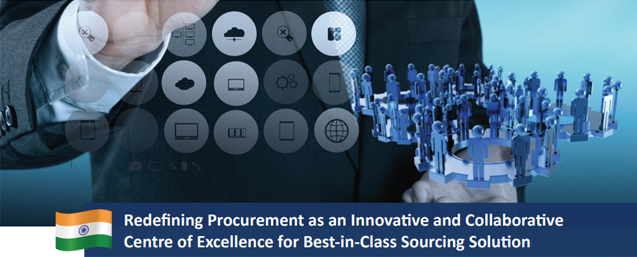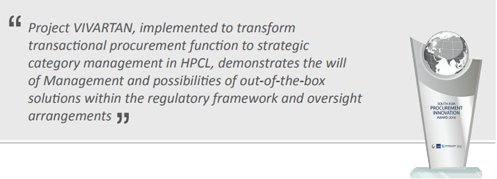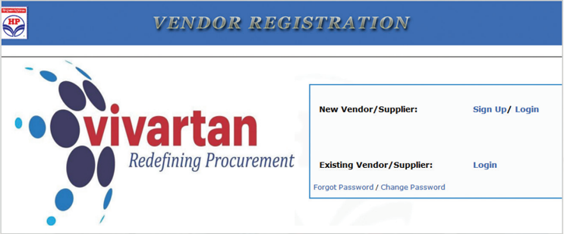Feature Stories
- How Bangladesh bridged the gap between amateur and professional in government procurement
- Rated Criteria: Promoting Value in World Bank Procurement
- Public Procurement Transformation in Bangladesh
- Achievement of Value for Money and Enhancement of Efficiency, Economy and Transparency in Procurement - Document Archive System
Archives
- End-to-End Procurement Planning and Maintenance System Integrated with Project MIS
- Application of Construction Milestones in Rural Road Contracts of Nepal
- Gross National Happiness Model for Pursuing Sustainable Public Procurement
- Government procurement is the basis of wide opportunities for enterprise development
- The Challenges of Procurement Training in a Fragile Country: the Afghanistan Experience
- When and How to Open Contracts: Transparency and Engagement through World Bank Projects
- Innovations and Best Practices in Procurement Processes of Disaster Recovery Projects
- World Bank Experts Discuss Global Procurement Trends and Armenia's e-GP system with the National Assembly
- Technology driving transparent and accountable public procurement reform in Bangladesh
- Prototype for Implementation of Framework Agreement via Blockchain
- Construction Project Planning and Management Capacity Building in India: A Wholistic Approach to Boost Infrastructure Development
- Zimbabwe: Public Procurement reform to catalyze greater transparency and development
- 15th Procurement, Integrity, Management and Openness (PRIMO) Forum
- e-Procurement World Map
- Preventing and controlling corruption: A modern approach to Procurement
- 6th South Asia Public Procurement Conference held in Thimphu, Bhutan
- South Asia Procurement Innovation Awards 2018 Announced
- Procurement iNET completes 5 years and new CPPP Fastest 100% Challenge Launched
- Risky Business: Does Debarring Poor Performers Mitigate Future Performance Risk?
- Global Procurement Summit 2019, New Delhi, India
- World Bank India launches Survey for International Civil Works Contractors
- World Bank launches new Complaints Module in Systematic Tracking of Exchanges in Procurement (STEP) System
- New Open Contracting Data Standard for e-Procurement Systems Launched
- Bangladesh's success in public procurement: Sustained reform really pays off
- The five drivers for improving public sector performance: Lessons from the new World Bank Global Report
- South Asia Public Procurement Innovation Awards 2018
- Conversation with Khaled Elarbi, President, High Authority for Public Procurement (HAICOP), Tunisia on the Digitalization of Public Procurement
- Breaking the glass ceiling in Africa: Rwanda E-Government Procurement System
- How government e-marketplace is revolutionizing procurement in India
- Ensuring Value for Money in Infrastructure Projects - The Botswana way
- Blockchain Lessons for Procurement
- Botswana’s Benevolent Move to Enhance its Procurement Profession
- Achieving Better Value for Money Using e-Auction for Procurement of Goods by Public Sector - A Success Case from DPDC
- Guide to Project Management and Contract Management (GPMCM) – New Approach to Improve Efficiency and Effectiveness of Procurement Outcomes
- Regional Winners of SAPIA 2017 participate in 8th International Public Procurement Conference (IPPC 8) Arusha, Tanzania
- The Future of Public Procurement in the Era of Digitalization
- World Bank Operations Procurement Helping Turkey to Procure a US$2 Billion Gas Storage Facility
- Unlocking Energy Efficiency Market in India - Through Innovative Procurement Business Model
- Getting value for money: Creating an automated market place for farmers in Pakistan
- Towards a Single Market for Public Procurement in Caribbean Small States
- Web-Based Online Evaluation Tool (e-Tool) for Procurement of Works by Royal Government of Bhutan
- Strengthening Health Sector Procurement System Offer Hopes for Universal Health Coverage in Nepal
- Morocco makes Strides in Modernizing its Public Procurement System— Operationalization of the Procurement Regulatory Body
- Innovations in Procurement Process and Selection that Lead to Improved Outcomes – Tenderers’ Database Management System
- Looking Back and Forward: The World Bank’s Procurement Framework
- Independent Monitoring and Evaluation of Contracted Health Services Leads to Improved Outcomes in Rural Areas of Afghanistan
- Fifth South Asia Region Public Procurement Conference brings focus on Procurement in Public Service Delivery
- 12 Procurement Innovations from South Asian Countries Celebrated
- Social Media is Improving Procurement in Lao PDR
- ASEAN meeting explores ways of professionalizing public procurement to meet development challenges
- Second International Training Program on the World Bank’s New Procurement Framework
- South Asia Procurement Innovations Award 2017 launched with Bigger and Better Prizes
- How to bid, finding opportunities, what makes a successful bid
- Pushing boundaries in procurement framework implementation
- Experience of Developing PPSD for the Assam Agribusiness and Rural Transformation Project (APART), India
- An Electronic Approach: Streamlining Georgia's Procurement
- South Asia Heads of Procurement Knowledge Exchange Program to U.S. Government Procurement Systems started
- 13th Procurement, Integrity, Management and Openness (PRIMO) Forum - a Documentary
- Bangladesh to strengthen public procurement with World Bank supported Project
- Establishment of Technology-Based Health Procurement and Supply Chain Management System, and Capacity Development in Tamil Nadu Medical Services Corporation
- Towards a Single Market for Public Procurement in Caribbean Small States
- Redefining Procurement as an Innovative and Collaborative Centre of Excellence for Best-in-Class Sourcing Solution
- India’s PowerGrid Endorsed for Alternative Procurement Arrangements by the World Bank
- Achieving Value for Money in Indonesia’s Geothermal Project
- Citizen Monitoring of Rural Roads Under Pradhan Mantri Gram Sadak Yojana (PMGSY), India
- Establishment of Grant and Service Contract Management Unit (GCMU) to Manage Contracting Out of Health Services in Afghanistan
- Procurement for Regional Development–Public Policy Initiative in Sri Lanka
- PPAF Community-Driven Development (CDD) Procurement Model, Pakistan
- Making Successful Procurement of IT Systems - An Experience from Vietnam
- Procurement Observatories continue to deliver in India
- Implementation of National e-GP System in Nepal
- Government e-Marketplace (GeM), India
- Africa High Level Public Procurement and Electronic Government Procurement Forums
- Development of Procurement Cadre as Part of Holistic Procurement Reforms in Bhutan
- Modernizing Public Procurement in Zimbabwe, one Step at a Time
- Citizen Engagement During Public Procurement Implementation in Bangladesh
- Winter 2017 Virtual Procurement, Integrity, Management, and Openness (PRIMO) Forum on Sanctions and Debarment Systems
- Close and Personalized Procurement Monitoring, Leading to Procurement Efficiency in Irrigation Sector in Fragile and Challenging Environments of Afghanistan
- Procurement Framework 2016 offers wider choices to ‘Go to Market’ based on PPSD
- Procurement Framework 2016 - Benefits, Status of Roll-out and M&E Arrangements
- PPSD offers Fit for Purpose Procurement Solutions
- Global Procurement Summit
- Fourth South Asia Region Public Procurement Conference
- The World Bank e-Procurement Tools
- South Asia Procurement Innovations Awards, 2016
- Learning Videos launched on STEP, online tracking tool on procurement for World Bank Projects
- Open e-Learning is Building a Cadre of Procurement Experts
- South Asia Region Public Procurement Conference, 2017
- Online Certificate Program in Public Procurement in Arabic Launched in Egypt
- First Procurement Knowledge Exchange Forum among ASEAN Countries
- Nobel Prize in Economics for contribution to Theory of Contract
- The Africa Region Harnesses Integrated e-Government Procurement (e-GP) Systems in Pursuit of Transparency and Integrity
- Procurement Reform for Humanitarian and Development Challenges in Kurdistan Region of Iraq (KRI)
- Successful Procurement is not just a set of Activities, it is a Strategy
- Afghanistan - Trends and Recent Developments in Governance
- PPSD is an Opportunity for clients and staff for Improved Procurement Management
- Procurement Reform Advances in the MENA Region
- Data Analysis and Collaborative Work in Action for Expedited Disbursements in Africa
- Ensuring Good Governance in Procurement in Sri Lanka
- New Procurement System to Improve Development Impact and Transparency in South Asia
- World Bank, USTDA Formalize Procurement Partnership
- How the New Procurement Framework Will Benefit 45.6 Million People in India
- Procuring the Future
- Reasons to Bid, Finding Business Opportunities
- New World Bank Procurement Framework Promotes Strengthened National Procurement Systems
- The readiness for Procurement Framework 2016
- 6 Things to know about New Procurement Framework
Redefining Procurement as an Innovative and Collaborative Centre of Excellence for Best-in-Class Sourcing Solution


{This article is an abridged version of the submission on “Redefining Procurement as an Innovative and Collaborative Centre of Excellence for Best-in-Class Sourcing Solution” madeby Mr. S. K. Chowdhury, Head – Integrated Support Function, Central Procurement Organization, HPCL, India, for the South Asia Procurement Innovation Awards.}
Summary
Project VIVARTAN is an organizational transformation initiative of changing transactional and process-oriented procurement to strategic category management, implemented by Hindustan Petroleum Corporation Limited (HPCL), a US$ 30 Billion Government of India Undertaking. Within all constraints of following public procurement regulatory requirements, Project VIVARTAN has become instrumental in achieving the end objective of value creation from the supply base.
Through a structured bottom-up cost estimation method; creating 150,000 unique structured and standardized items’ codes; category-based annual procurement planning and sourcing strategy; and using an end-to-end, state-of-the-art E-platform handled by certified employees on higher levels of procurement learning, Project VIVARTAN resulted in 10% cost savings, 40% time savings and 70% increase in vendor participation in the very first year.
Background
Hindustan Petroleum Corporation Limited (HPCL) is a Government of India Enterprise, with its annual procurement spend at 1.5 Billion US$. Procurement by HPCL used to operate as more of a transactional, processoriented function at different Strategic Business Units (SBUs), with limited focus on strategic, category concept. In the aftermath of globalization and eroding bottom lines, Project VIVARTAN, a transformation initiative, was launched to redefine HPCL Procurement as an innovative and collaborative center of excellence. It was implemented under a cross-functional Project team headed at Executive Director level, with members from SBUs, Refineries, Zones, Regions, Plants, Terminals, Legal, and Finance, with support from Consultants, M/s AT Kearney (ATK).
Project VIVARTAN was undertaken in 2 phases (i) As Is Study: The study of past procurement data, interviews, meetings, discussions, and workshops on existing procurement landscape and improvement areas, against global benchmarking. Based on the study’s assessment, a design road map was laid down starting with a visioning exercise, where CPO Vision / Mission statement and Logo for Project “VIVARTAN” were finalized. Sourcing spectrum was strategically divided into several category buckets with a clear transition road map. (ii) Phase II: With requisite manpower positioned, the pilot categories identified were taken up for implementation with handholding of consultants. Category-centric sourcing and contracting approach was adopted with introduction of the Category Management Concept. The Strategy for each category was finalized after an in-depth market research and study of global best practices.

Following are the major challenges addressed:
- Challenges of consolidating demand due to distributed spending without specification standardization and item codification.
- Capability Building – Procurement was not a cadre comprising trained and certified professionals with adequate domain knowledge fit for strategic sourcing.
- Apprehension within SBUs of losing control over the function.
- Cumbersome processes followed without SoPs posed issues for switching over to a complete E-platform.
- Limitations of being part of Public Procurement regulations (GFRs), wherein open tendering has limited flexibility and there is restricted level of collaboration with vendors.
- Socio-economic obligations of adhering to policy needs for preferential procurement that limits competition.

Innovation has been the hallmark of this project and was instrumental in achieving the end objective of value creation from the supply base. It involved:
Category Strategy: Basis the Past spend pattern, Suppliers profile, Market analysis and Global trends witnessed within the best-in-class companies, HPCL spend is categorized into different buckets, allowing Category Managers to draw the right category strategy.
Innovative short-time / long-time strategies were introduced, such as Change in Share of Business, Global Tenders, Developing Alternative Specification / Material, Life Cycle Costing, and Costing-Based Net Value Realization.
Cost Estimation Cell as Centre of Excellence and Price Banding: Introduced as an innovative tool to break the Vendor Cartel under select categories, CPO could use the Bottom-up Costing tool very effectively for getting a competitive price from bidders at markets, which have historically seen high quotes as results of cartel.
Reverse Auction: The online tender platform was strengthened with additional features, such as Reverse auction, Online collection and refund of Tender fee / Deposits / Retention money etc., to make it an end-to-end online solution. With higher business volumes at stake as a result of consolidation, reverse auction saw a stiff competition among bidders, resulting in very competitive rates being finalized and providing huge saving to the corporation.
Specification Standardization and Uniform Item Codification: Uniform item codification project was executed, wherein more than 1 million past procurement data were scrutinized, cleansed, and standardized to obtain 150,000 Unique specifications with Items codes in Master data format. This was done with the help of domain experts as external consultants.
Vendor Data Base Rationalization: HPCL Vendor Database had around 200,000 Vendor Codes, most of them duplicates created in a decentralized environment by different business units. The Vendor Management team of CPO initiated the activity of cleansing the Vendor base to come out with 96,000 Unique Vendor Codes to facilitate consolidated order placement, vendor performance evaluation and tracking.
Capability Building: Building suitable capability among the workforce is one of the prerequisites for any organization to be successful. The Certification course conducted by United Nations Development Program at CIPS Level II and Level III Certification in Public Procurement for all CPO personnel was the step taken to create a pool of certified professionals in the field of procurement.

Impact Generated
The shift from transactional model to strategic category management led to the following impacts:
- Establishment of a Cost Estimation cell introduced price banding for categories with structured bottom-up cost estimation method for arriving at Costing and Price Banding. Apart from breaking the threat of Vendor Cartel, a saving up to 10% over benchmark was witnessed in initial tenders itself.
- Uniform Item Codification project led to standardization of specifications as a prerequisite for demand consolidation across the Corporation. Unique 150,000 items’ codes were created in a structured, standardized format by the item codification team. This enabled Accurate Annual Procurement planning, eliminated ambiguities and queries at bidding stage, provided accurate inputs for analytics, and supported business intelligence.
- Category-based sourcing strategy, based on past procurement data, annual procurement plan, and detailed supplier market assessment, led to a tangible saving of approximately 10% over past spends, with the larger volume attracting Global Vendor Participation. 70% increase in vendor response was observed in the very first year
- End-to-end, state-of-the-art E-platform contributed to reduction of the cycle time by 35-40%, while promoting the green initiative of the Corporation.
- Rationalization of Vendor Database and Unique Vendor Code: This made tracking of project progress easier and also simplified the process of Vendor Performance evaluation.

Scalability and Sustainability
Project VIVARTAN is used for all procurements in HPCL. Its implementation shows that these innovative approaches, if replicated in the Public or Private sector, can bring in tremendous value in terms of increased quality, reduced purchase cycle time, increased saving, and discipline in procurement processes. Standardization and codification of items led to ease of consolidation in demand across the company and helped lower the inventory holding cost. The E-platform, which is transparent and secure with rich features, such as Reverse Auction, E-collection / Refund of EMD / Tender fee etc., will also boost the green initiative.
Developing a robust category strategy, based on in-depth supplier market assessment for high spend items, is the direction in which the public sector needs to move. Initiatives like Project VIVARTAN are implemented within the same regulatory framework and vigil or oversight institutions that are often pointed to as determinants of red tape and inefficiency. Evidence of cost savings, efficiencies achieved in time, as well as increased bidder participation, proves the financial and organizational value addition of the project.


Following are the lessons learned as a result of successful implementation of Project VIVARTAN:
- Establishing an appropriate benchmark by investing time and leveraging global best practices for developing a robust procurement category strategy at the planning stage is essential. Category Profiling and Supplier Market Assessments are the two most important ingredients for development of Category Strategy.
- Collaborating with Vendors: The Pre-Tender Meets started at HPCL CPO were instrumental in getting crucial inputs, which helped in firming up Specifications, Terms and Conditions, apart from developing the right category strategy for improved Vendor Response and better Value for Money.
- The E-platform with features, such as reverse auction, E-collection and refund of Tender Fee / Deposits, E-chartering etc. complemented the process efficiency in total.
- It is important to launch a Certification Program to develop a procurement cadre of certified professionals, with complete knowledge about best practices in public procurement at global level. This effort must be at the professional level with strategic procurement coverage.
- Strong Management Focus and Support is an important factor for the success of any project of this magnitude. Management commitment towards the project was reflected in formation of CPO project team headed by Executive Director, engaging renowned consultants, and establishing a Steering Committee of higher management for periodically assessing project progress and providing quick policy decisions. These played a vital role in completion of the project as per schedule.
